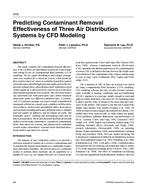
4532 — Predicting Contaminant Removal Effectiveness of Three Air Distribution Systems by CFD Modeling
- Comments Off on 4532 — Predicting Contaminant Removal Effectiveness of Three Air Distribution Systems by CFD Modeling
- ASHRAE
This study compares the contaminant removal effectiveness (CRE) of three air distribution systems for a bar/restaurant setting by use of computational fluid dynamics (CFD) modeling. The air supply distribution and exhaust arrangement were modeled for a mixed air system, a directional air flow system (where air moves in a unidirectional flow pattern across the space, from the high-pressure supply area to the low-pressure exhaust area), and a displacement ventilation system (where supply air is delivered at low velocity close to the floor, allowing thermal plumes to be created). The CRE of each space was determined for both particulate and carbon monoxide dispersions under two different ventilation rates. A commercial CFD software package was used to model a hypothetical restaurant with bar in a steady-state condition with the inclusion of objects, such as a bar and multiple tables, heat sources such as people standing and seated, pollutant sources, multiple four-way supply air diffusers, and an exhaust air grille. The hospitality spaces’ smoking and nonsmoking zones had no physical separation. The results demonstrated that directional airflow systems reduce nonsmokers’ exposure to contaminants better than mixed air systems, and displacement ventilation systems reduce nonsmokers’ exposure better than both directional airflow and mixed air systems.
Units: SI
Citation: ASHRAE Transactions, vol. 108, pt. 1, Atlantic City, 2002
Product Details
- Published:
- 2002
- Number of Pages:
- 10
- File Size:
- 1 file , 5.5 MB
- Product Code(s):
- D-6972

